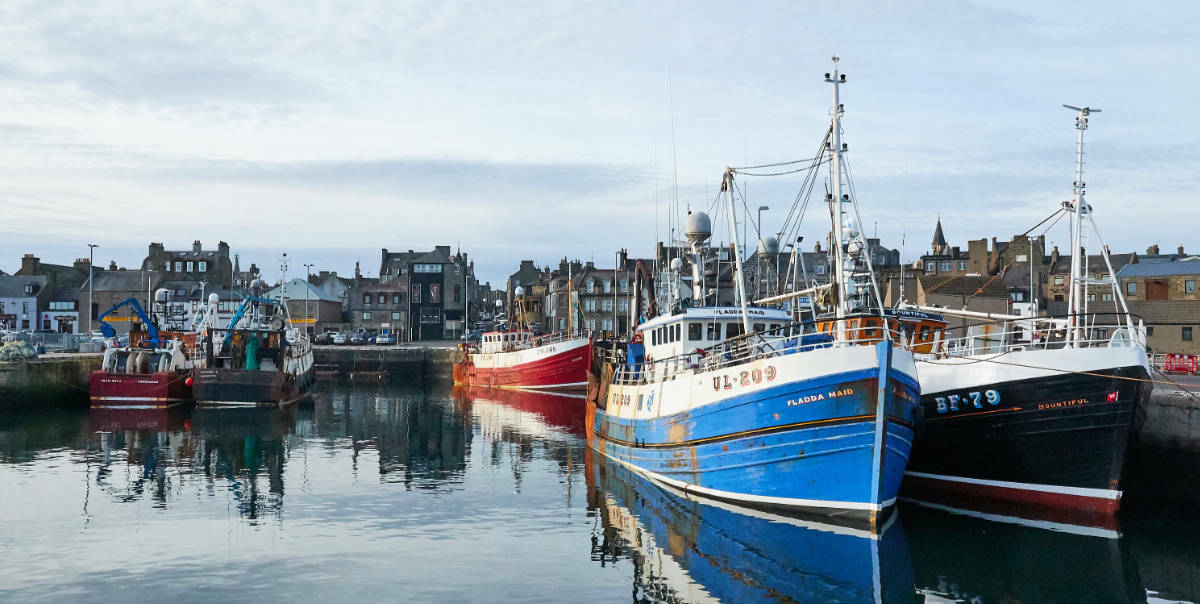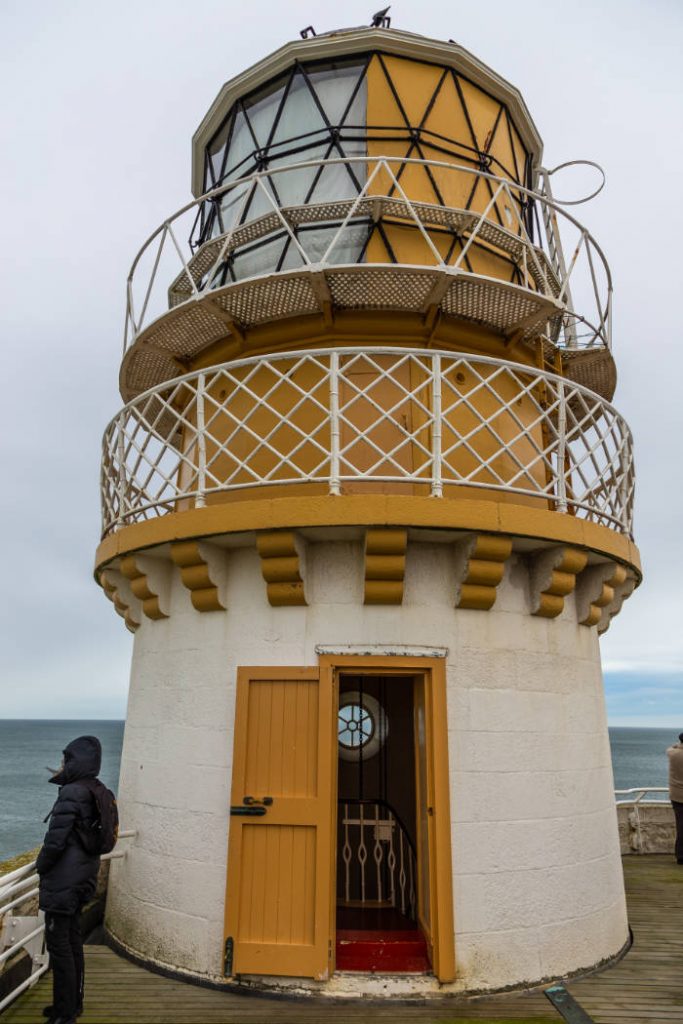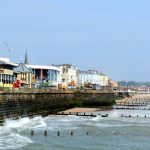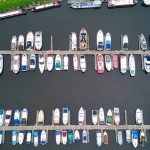
The old port town of Faithlie, sometimes called ‘The Broch,’ Fraserburgh is a town of many names.
Fraserburgh has its roots in the 16th century, but we all know the land will have been clan land before then. Situated in the far northeast of Aberdeenshire, this is one remote large town that is famous for fishing. In fact, it has held the title of largest shellfish port in all of Scotland for generations now. We might not eat much shellfish, but Scottish crayfish, mussels, and prawns find their way all over Europe where they are sold as delicacies. And what do we eat in Scotland? Battered and deep-fried Mars Bars.
Currently, Fraserburgh lands over 5k tonnes of shellfish every year, and 90% of it is shipped abroad. Let’s see what else we can find out about this lovely location to report back as tour guides.
Here’s everything you need to know about Fraserburgh.
The Clan Lands of Fraserburgh
The town of Fraserburgh took its name from the Frasers of Philorth. The Laird of Philorth built Fraserburgh Castle and bankrupted himself in the process. We can assume that the clan built the castle on an earlier fort, hence why the town is sometimes referred to as the Broch. The Frasers were lowlanders, so it’s almost surprising to find them so far north. They came over from France, like many lowland clans, around the 1400s. The Frasers came from the Anjou region of France to build Castle Fraser in Sauchen, also in Aberdeenshire.
Clan Fraser had their original lands near Buchan when clan Buchanan was dominant. They bought the lands of Faithlie at Kinnaird Head in 1504 and eventually made it a burgh of a barony in 1546. The clan built Pittulie Castle in 1596. Alexander Fraser established Faithlie in 1592 after James VI issued a charter for a town. He made improvements to the harbour with a view to making it big enough to rival Aberdeen. The town was to have a university as well, but the Laird bankrupted himself building Fraserburgh Castle, and had to sell the lands at Philorth to pay for it. A huge mess.
The first Fraser came to Scotland in the 11th century. Simon Fraser owned the Keith lands in East Lothian. His granddaughter became heir to the Keith family, who have a close allegiance with the Frasers. Sir Simon Fraser fought for Wallace at Rosslyn in 1302 and was captured fighting for Robert the Bruce in 1306. A thoroughly noble clan. After this, they expanded north and east, which explains how they ended up in Fraserburgh.
Let’s talk briefly about the town of Rattray to the south of the headland. Now… the Clan Rattray is a Highland Clan who have their roots in Perthshire. They were the ambassadors to the English in the 1400s and their Laird died in the Battle of Flodden. It makes sense that they would have small holds and villages throughout the country.
Early Days of Fraserburgh
The town itself came about with great investment from the Fraser family. When they arrived, it was nothing above a small port and fishing village. They had great plans for the town, even if not all of them came to fruition. They spent the first century of its life pampering it and building it up. In 1570 the castle was built on Kinnaird Head and they added a church a year later. In 1576 the first stone was laid on the pier by the Laird. Faithlie became Fraserburgh officially in 1592. In 1594 Alexander Fraser built a college and in 1597, appointed a reverend.
The college didn’t last more than a decade and, in 1601, the town became a burgh of regality. There was an outbreak of plague in 1647 which forced Aberdeen King college to briefly relocate here. In 1601 the town became a free port, which meant they could charge taxes. The records show that men played golf here in 1613 when the church notes a man named John Burnett played golf instead of attending Sunday service at the church!
Fun & Not So Fun Trivia about Fraserburgh
In this section, we always try to name some of our favourite pieces of trivia from any given area. Fraserburgh is a fun place to take a closer look at, so we surmise it will be a good place to visit for your staycation, too. Here are our favourite facts about Fraserburgh that will make you look smarter at parties:
- We mentioned briefly before that it was the shellfish capital of Scotland, but it also lands its fair share of white and pelagic fish.
- The old nickname for the town is The Broch, which means the fort. It is now the local Football Teams nickname.
- Fraserburgh fish travel all over the world and have been since the railway opened in 1865.
- Fraserburgh was the first town in Scotland to house an RNLI team. The station opened in 1858 when it took over lifeboat services from the Harbour Commission.
- On a darker note, Three lifeboats capsized here over the years. In 1919 The Lady Rothes killed 2. In 1953, “The John and Charles Kennedy” capsized in the harbour entrance, killing 6. In 1970 the Duchess of Kent capsized 38 miles offshore. Five of the Six crew were lost at sea.
- Broadsea Village used to be a separate town but is now part of Fraserburgh. This was traditionally where the fishermen and their families lived.
OK, so some of those facts were morbid instead of fun, but they were all trivia. Let’s get back to the history so we can find out what the attractions are, down the line.
The Industrial Revolution
By 1755 there were 1,682 people in the census in Fraserburgh. Although it didn’t live up to the Laird’s population dreams, it was a respectable size for a fishing town. An official Fraserburgh Golf Club opened in 1777 for the first time, giving those heathens somewhere to play at last. The Laird (another Alexander Fraser) sold the castle to the Northern Lighthouse Board, to help stave off mounting debts. The castle changed hands in 1786. The following year the Lighthouse Board opened Kinnaird Head Lighthouse in the tower.
A second church opened in 1791, named St Peter’s Episcopal.
Fraserburgh had a period of growth during the herring years. Throughout the 1800s, several ports around Britain brought in hundreds of thousands of tonnes of herring thanks to a new type of fishing. Fraserburgh prospered from herring fishing until the 20th century. Scotland was susceptible to the herring industry to the point that the government established the hated Herring Board. If you caught too many fish, you had to chuck them back in. The EU set up similar rules to prevent overfishing. To trawlermen with single boats, it seems barbaric, though it makes a difference to fish populations.
There is a line in a Louis MacNeice poem about the Herring Board which is typically Scottish, even though he was an Irishman.
“His brother caught three hundred cran, when the seas were lavish. Threw the bleeders back in the sea and went upon the parish. It’s no go your Herring Board, it’s no go your bible, all we want is a packet of fags for when our hands get idle.”
And that’s fags as in cigarettes, please don’t send in any complaints! It’s a good poem that encapsulates Scottish culture. Check it out.
In 1806 the town received its first lifeboat, courtesy of the Harbour Commissioners. They controlled it until the 1850s. The North Pier opened in 1812, having taken 5 years to complete. In 1811 the town had 2,271 residents according to the census. The south pier at Fraserburgh Harbour opened in 1818.
The Harbour Commissioners added the southern pier because the northern pier didn’t shelter the vessels well enough. By 1831 that census showed 2,954 souls in town/ They received their first newspaper, the Fraserburgh Advertiser, in 1852. Three years later the town built the townhouse for taxation and such.
The Train Arrives
In 1855 the Harbour Commission decided to rebuild the northern pier but to do it right this time. An RNLI station opened in 1858 in Fraserburgh. The townsfolk were trailblazers in other ways, too. They opened a school for women in 1863, although it was a Girls’ Industrial School, meaning they were priming them to work in factories or mills. The railway finally reached Fraserburgh in 1865, about 20 years plus after it left London. It’s a long way so we forgive them.
The Fraserburgh Academy opened in 1872. Five years later, the West Quoad Sacra Church followed suit. The town received a new sewage system in 1877 and a new public school in 1882. They crammed a lot into these 20 odd years!
20th Century Fraserburgh
The town received its own foghorn at the beginning of the 20th century. If you have never heard the foghorn before, consider yourself safely out of the region of towns where horror stories happen. It is the creepiest sound to ring out across the water. It’s usually calm when the fog rolls in. You may or may not be familiar with the “Scotch Mist,” which is what locals call “Har.” The har off the water is the phrase used to describe the mists rising low over lochs and inlets. The mist comes off the water and drifts ashore, but it can be deadly to sailors. The foghorn lets sailors know they are close to the shoreline and not to drift closer, guiding them safely away from land in thick fog. But it’s spooky as hell.
Fraserburgh football club opened in 1910 and continues to this day. The population was 10,574 as of 1911. Fraserburgh was home to the RNLI’s first motorised lifeboat in 1915. She was called “The Lady Rothes.” Fraserburgh football club was invited to attend the Highland League in 1921.
Royal Visit
HRH Princess Margaret attended the Fraserburgh Academy in 1962 to officiate the opening ceremony. It takes a while but royalty get there in the end. Towards the end of the century, the lighthouse closed and sent to the Museum of Scottish Lighthouses. A heritage centre opened in Fraserburgh in 1998.
More recently, the town received a new lifeboat and the population steadied out above 12,000 or thereabouts. Fraserburgh is a town filled with people descended from clansmen and women with remarkable resilience. To first move here from France, then progress up farther and farther north into the bleak wilderness and cold of an unfamiliar country took guts. The people of Fraserburgh are sharp, tough, and welcoming to unfamiliar faces. It’s a striking place where each day greets you with a view of miles of ocean. Oh, and you can have all the shellfish you can eat.
Famous People from Fraserburgh
When we review towns and cities, we like to dig up the dirt on who the famous faces are about town. We need to be prepared so we can act casually when they contact us in the supermarket. Here is a list of all the famous people from Fraserburgh that you may need to look up before you get there…
- Dennis Nilsen was from Fraserburgh, which is not something to advertise. There have been very few Scottish serial killers and Dennis was one of them. He was also a necrophile. He killed at least 12 men and young boys in London, but he was born here.
- One of the famous Scottish Merchants of the early 1900s was Thomas Blake Glover.
- George Strahan, an actual coloniser… wow Fraserburgh, it’s not looking good.
- Oh, thank goodness, James Ramsay, a famous anti-slavery campaigner, balancing out the scales of evil in the north.
- VC recipient Joseph Watt
- Steve Fairnie, is a musician, painter, sculptor, actor, and many other things.
So there are plenty of famous people to have come out of Fraserburgh to grace our screens. Let’s leave all this behind us now and move on to the famous things to see and do in town, rather than faces.
Fraserburgh Attractions
In this section we will try to list as many of the top sights to see in Fraserburgh, should you wish to stop for a holiday.
Historical Sites and Landmarks
If you head out to Rosehearty, you will eventually come to Pitsligo Castle. This ancient ruin is an excellent example of a traditional Scots castle built in the 16th-century style. Erected in 1570, it was the property of the Forbes of Druminoor. The keep that it was built on top of was erected in 1424. IT has housed both the Forbes and the Erskine clans over the years. Now it is partially restored but mostly ruinous and makes a lovely day out. What a surprise: part of the courtyard is credited to the Frasers of Philorth.
If you are looking for family ties to the area, Rosehearty Library is your best bet. Visit it while you are seeing the castle. It operates as a public library and sometimes puts on events or hosts authors.
Galleries and Museums

Image: Tomasz Wozniak/Shutterstock.com
The Museum of Scottish Lighthouses is one of Fraserburgh’s main attractions. Rather than move the lighthouse at Kinnaird Head to the museum, they turned it into the museum. You can tour the parts of the castle that the team have restored, or you can scale the tower for the view. You can see the working parts of the lighthouse, which is awesome. There are all sorts of lighthouse based fun facts and information going on.
You can visit the Fraserburgh Heritage Centre most of the year, though it was damaged by Storm Arwen late in 2021. The entire roof got blown off. If you can help, head to their home page and donate. The heritage centre details the lives of the locals, the history of the town and Clan Fraser, and the wonders of the Scottish fishing industry. It would be a terrible shame if it was not restored.
Outdoor Attractions
Fraserburgh Beach is a massive yellow sand beach, complete with dunes. It’s not that busy either, since the town isn’t that big. Be wary of weekends in high summer when other towns flock to the beach. Overall, there are loads of walks through the dunes and lots of sunbathers.
Another popular outdoor attraction in town, which is semi-indoors, is the Willows Animal Sanctuary. Kids adore this place, and they have a varied mix of reptiles, cute and cuddly animals, and other rescued wildlife. They have horses, cats, dogs, turtles, sheep, cows, goats, mules, rabbits, and everything in between. You find them on the road to Banff, which sounds like a made-up place, but isn’t. They have a shop and welcome donations. They are a charity so a day out with them is well-spent.
Sports and Recreation
Fraserburgh is home to its own golf club of the same name. Scottish towns ordinarily have many golf clubs in striking distance, but Fraserburgh is out there on the headland on its own. It is the 7th oldest golf club in the world.
Fraserburgh Leisure Centre is the place to be in town. It has its own bowling alley so it’s not just for the gym and hall hire. It has a restaurant, function hire, a bar, pool, snooker, and more.
We better not neglect the football team. Fraserburgh FC is still going strong. They are full members of the Scottish Football Association.
Shopping and Retail
The best shopping is around the harbour, in the east end of town. There are no large shopping centres here, though Peterhead isn’t far to the south. There are plenty of boutique shops on the high street to buy gifts from. They also have enough grocery stores and clothes shops that you can find most of what you need.
Other Notable Attractions
If we have missed anything out above, you should find it in this section. We also included a few attractions from the surrounding Aberdeenshire countryside to keep you amused:
- Fraserburgh Library is an impressive building, great for IG shots and, you know, books.
- Locals often find themselves drinking in the Mormond Inn.
- If you are willing to travel a little, the Inverallochy Golf Club is worth a visit for those who like to wield a club.
- Both Fraserburgh and Rosehearty have lovely old harbours that you can wander around. Speak to the fishers or have chips on the seashore.
- Visit Cairnbulg Beach just out of town for a quieter time on the seafront in better weather.
There are lots of things to do all up and down the coastline in Aberdeenshire (you must visit the village of Pennan). It’s a stunning county that deserves more attention. We advise that you hire a car and get out to explore it.
How to get to Fraserburgh
If you are wondering how to get to Fraserburgh, have no fear. We can give you the best basic directions in town but download a map to be on the safe side.
By Road
If you were to head north out of Aberdeen on the A90, Fraserburgh is the end of that road. Past Peterhead and on to the tippy point of Scotland.
By Rail
Fraserburgh railway station fell victim to the Beeching cuts in 1965 and the freight offering ended in 1979. The closest you will get is Inverurie.
By Air
The nearest airport is Aberdeen International.
By Sea
You are looking for Fraserburgh Harbour. Follow the trail of shellfish boats.
Got Five Minutes?
If you find that you enjoyed our little guide here and you need more, you’ll get plenty of tour guides similar to this one over on our home page. You can keep track of updates here at Five Minutes Spare if you follow us on Facebook, which is a great way to show s


